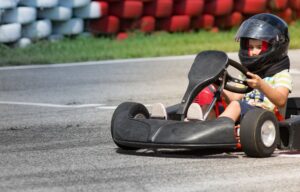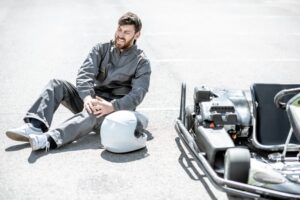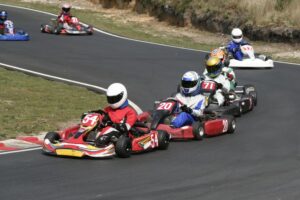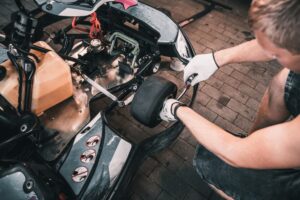Picture it: Maryland 2005, in the midst of a sweltering summer. I was working at a kids’ camp, and one fine day we took the children to an adventure park. The place featured fun activities such as bumper boats, laser tag, and go-karting. The kindergartners weren’t old enough to drive the karts themselves, so I volunteered to drive a few around.
I was hugging the curves, gaining speed, and passing all the other kids, until I rounded a corner and saw a huge pileup in front of us. I slowed to a stop and was waiting for it to clear when, suddenly, BOOM! I was rammed from behind by a counselor from another camp.

My vision whited out, I could barely think straight, and my left shoulder and collar bone area immediately started aching. Through my haze, I checked on my passenger who was, thankfully, fine. As the day progressed, I became more confused and nauseous. My head and shoulder continued to throb. I was eventually diagnosed with a concussion, and I had separated my collar bone. After several visits to the orthopedist and many physical therapy appointments, I was back to normal, though that collar bone still protrudes a bit even now.
When I started my day, I had no idea what disastrous consequences that would occur. Go-karts are marketed as a fun activity for children – much more simple and safer than driving a real car! But in reality, they can cause injuries and even death.
Less about me, more about go-karts
The Consumer Product Safety Commission (CPSC) defines a “fun-kart” as a motorized vehicle with four wheels intended for private personal recreational use. It’s designed for off-road use on suitable terrain at speeds between 12 mph to 40 mph. There is no country-wide standard for fun-karts, though the CPSC publishes a voluntary standard for best practices. However, one must purchase this information from them. At the time of this post being published, the cost is $63.
Why did I suddenly start calling them “fun-karts” you ask? That’s because fun-karts are defined as commercially manufactured, whereas the term “go-kart” can be used for both commercially-manufactured vehicles as well as homemade, consumer-modified, and consumer-built karts. This means there is no standard – voluntary or involuntary – for homemade or home-modified karts. In this article, I will use the word “go-kart” to address the safety risks of all types of karts.
Go-kart tracks also do not have a set standard. They can be located inside or outside, and feature variations such as track width, sight lines, and barriers. Plus, track surfaces can heavily influence the safety of a particular course.
Statistics on go-kart injuries

In 2000, the CPSC published a study regarding go-kart related injuries for 1999 and go-kart-related deaths from 1990 through 1999. Here’s what was discovered:
- There were 113 go-kart-related deaths involving children under 15 years of age during that time period.
- Most of the children involved were eight years old or older, and most were operators of the go-kart.
- In 1999, an estimated 12,600 children under 15 years old were treated in hospital emergency rooms due to go-kart-related injuries.
- Of those, 69% were male and 77% were between the ages of 8-14.
- The most common causes of injuries or deaths were collisions, either with stationary objects or a moving vehicle, and loss of stability.
Common go-karting injuries
The CPSC reported the most common go-karting injuries, which are as follows:
- Lacerations, contusions, abrasions
- Sprains/strains
- Dislocations
- Fractures
- Concussions
- Internal injuries
- Burns
- Punctures
- Avulsions
Most victims of go-karting related injuries are treated and released shortly thereafter. However, these injuries can result in hospitalization if severe enough.
Staying safe while participating in an unsafe activity

There are several ways to stay safe, or at least safer, while participating in go-karting activities. Some examples are:
- Wear a helmet, gloves, and neck brace.
- Avoid wearing loose-fitting clothing.
- Tie up long hair.
- Make sure your kart has a four-point restraint safety belt, a roll bar, and bumpers.
- Keep your hands on the wheel and all body parts inside the vehicle.
- Only go the speed you are comfortable with.
- Stay away from others who are displaying reckless or erratic behavior. Sometimes this may mean leaving the track and not continuing the race.
- If you are on an outdoor track, keep the weather in mind just as you would driving a car.
Who is liable for go-kart injuries?
Most go-kart injuries or deaths are the result of negligence. Sometimes it is the operator themselves pulling a risky move or going beyond their capabilities. But other times, it can be someone else’s negligence that causes these disastrous outcomes. So, who is liable for these injuries?
- Other go-kart drivers – Another driver may be liable for injuries if they negligently operated their vehicle in a way that caused harm to others. For example, the man who hit me could have been liable for my injuries.
- Race marshals – The employees staffing the tracks have a duty to prevent accidents as much as possible. If they were negligent in upholding their responsibilities, they can be held liable.
- Go-kart owners – The owners of the go-karts have a duty to make sure the vehicles are safe and in good working order. If their negligence directly caused an injury or death, they could be sued. This can sometimes be the company/location at which you are racing the go-karts.
- Track management companies – Both indoor and outdoor tracks require regular maintenance to keep the terrain safe for drivers. If a company negligently fails to maintain the track, and that failure causes injury, they could be found responsible.
- Go-kart mechanics – Go-karts need regular maintenance just like any other vehicle. If the mechanic negligently failed to notice or fix a defect in the kart that causes it to be unsafe and injure someone, they could be sued.

I got injured go-karting. What can I do?
If you or someone you know has experienced a go-kart injury through no fault of their own, please reach out to the experienced personal injury attorneys at Allen, Allen, Allen & Allen. Whether premises liability, product liability, or another issue, our attorneys can help you explore your options. For a free case evaluation, please call 866-388-1307.



